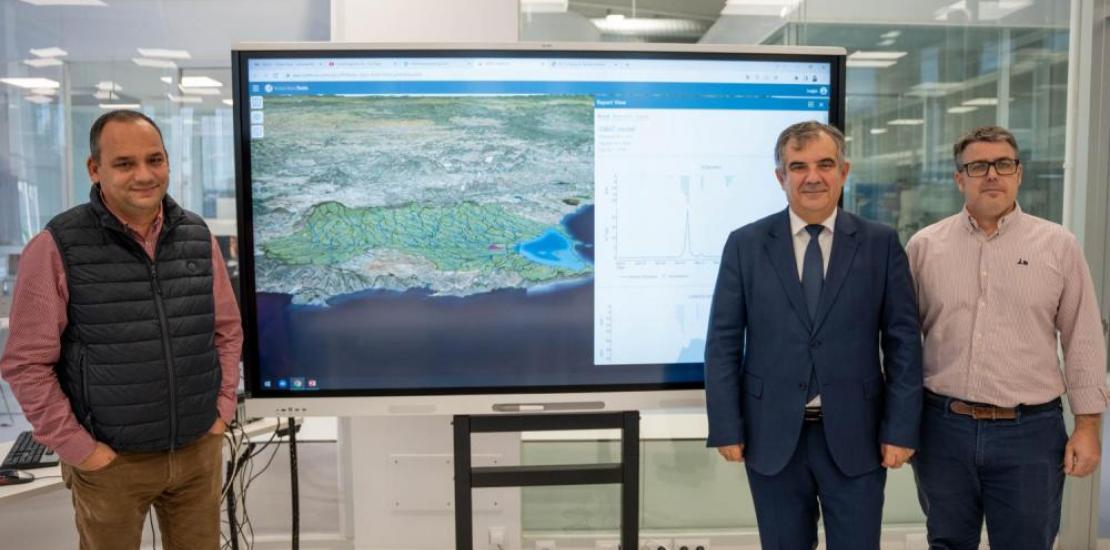The SMARTLAGOON project presents the digital twin of Mar Menor
Universidad Católica de Murcia has led this international research, endowed with almost 4 million euros by the European Union, to support decision-making for the recovery and maintenance of Mar Menor.
The SMARTLAGOON project, led by the UCAM Research Group ‘Planning and Management of Water Resources (Hydro MRLab)’, directed by Javier Senent and funded by the European Union through the Horizon 2020 programme with an investment of nearly 4 million euros, comes to an end after four years of intense work.
The greatest achievement of SMARTLAGOON has been the development of a digital twin of the Mar Menor, a virtual lagoon that integrates geospatial, climatic and agricultural data.
This system simulates the physical and ecological processes of the salt lagoon, forecasts its evolution and evaluates the consequences of the measures implemented by the sectors involved. This morning, Javier Senent, together with other researchers on the project, met at the UCAM HiTech high technology incubator for health, sport and food to present this digital model to Juan María Vázquez, Regional Minister for the Environment, Universities, Research and the Mar Menor, and Antonio Caballero, Director General for Universities and Research.
‘The digital twin developed is the only tool currently in existence capable of simulating in real time and in a coupled way several models, both of the basin and the lagoon, in order to predict the behaviour of key variables in the state of the Mar Menor such as oxygen or chlorophyll several days in advance, as well as the analysis of the effectiveness of the different measures proposed in the current legislation for the improvement of its environmental state, which is of great interest for decision-makers’, stresses Javier Senent, Principal Investigator of the project.
First intelligent floating device
To create the digital twin, several infrastructures have been implemented, such as the first intelligent buoy installed in the Mar Menor, which measures parameters such as temperature, salinity, chlorophyll, dissolved oxygen and turbidity in real time. In addition, four cameras have been installed to monitor several strategic points at all times, such as the Gola de Marchamalo, the Estacio channel and the Rambla del Albujón. All this information is essential for monitoring the ecosystem and predicting the changes it may undergo in the face of different factors and the state of the lagoon. The research team has jointly used the SWAT and QWET hydrological models, tools for the simulation of aquatic ecosystems, calibrated by artificial intelligence with meteorological data on evapotranspiration and soil moisture.
SMARTLAGOON has also analysed the effectiveness of current legislative measures in the framework of the Mar Menor Law. According to the study, the combined implementation of actions such as the installation of vegetation barriers, contour planting and fertiliser reduction could reduce nutrient inputs into the lagoon by up to 70%.
For Juan María Vázquez, the Regional Minister, ‘the most important thing is what it means; that the UCAM has led a process within a large European project, where experts and scientists from different countries around the world have contributed their knowledge. Moreover, in a very specific area in which we are in such need of information as the Mar Menor.’ He emphasised that this digital model provides information on what can happen ‘if the parameters indicate, through the digital twin, that something is changing or is being modified’.
For her part, Estrella Núñez, UCAM Vice-Rector of Research, stressed the UCAM's firm commitment to the development of international projects, through the OPRI, which ‘link the leadership of our researchers and the objective of carrying out quality research with respect to the needs of our Region. This is a clear case in which the funds attracted by UCAM in the H2020 call have been used to work for the Mar Menor.’
All the technology, information and tools developed in SMARTLAGOON will be handed over to the public administrations to guarantee their continuity and effectiveness in the management of the Mar Menor. For this reason, the researchers, after meeting with national and regional institutions, will go to the European Parliament next week to present this digital twin for coastal lagoons in Europe.
Project partners Universidad Católica San Antonio de Murcia (Spain), Universitat Politècnica de València (Spain), WaterITech APS (Denmark), Uppsala Universitet (Sweden), Norsk Institutt for Vannforskning (Norway), Universitá di Bologna (Italy), Photrack AG (Switzerland) y Vielca Ingenieros, S.A. (Spain).




